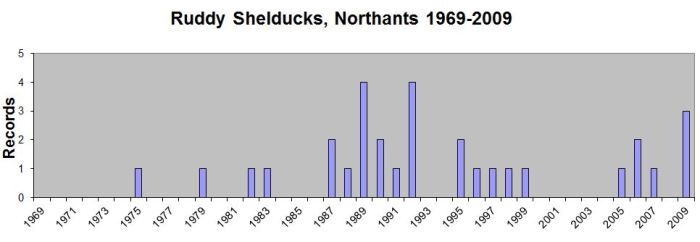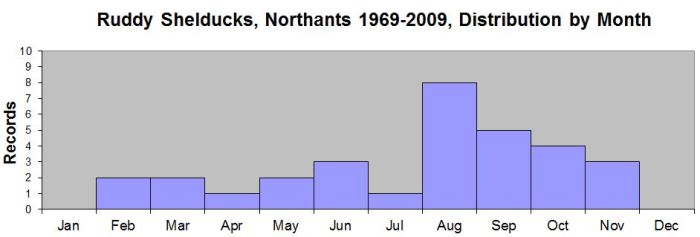A light westerly airstream dominated the first part of the week with a low pressure system in the eastern Atlantic bringing southwesterlies to the UK. This gave way to a Scandinavian high pressure system and a resultant easterly airstream out of Europe towards the week’s end.
The Pitsford Ruddy Shelduck remained throughout the week, continuing to fuel debate about its origins and the same site hosted the only Pintails of the week, three on 21st with a Garganey there on the same date. Single Garganeys were also at Clifford Hill GP on 20th and at Summer Leys on 21st with two there on 26th and one on 27th and the long-staying Goldeneye at Pitsford Res was joined by two more there on 21st.

A juvenile Marsh Harrier was again at Blueberry Farm, Maidwell on 22nd, followed by an adult male at Harrington AF the next day, while an Osprey visited Thrapston GP on 22nd and another flew west over Hardingstone on 25th. A male Merlin was at Blueberry Farm, Maidwell on 22nd and single Peregrines were seen there on 21st and at Summer Leys on 26th – a juvenile female – and 27th (an adult).


A better selection of waders was evident this week, although numbers of each species were relatively low. Ringed Plovers were the exception, though, with eighteen at Pitsford Res on 21st comprising four on the ground and a separate flock of fourteen flying over. The four on the floor had increased to seven by 24th and then reduced to five from 25th to 27th. Elsewhere one was at Clifford Hill on 21st and five were at Summer Leys on the same date, dwindling to four on 23rd and one on 26th-27th. After flagging up last week the complete absence of Little Stints this year one promptly appeared at Clifford Hill GP on 21st, quickly followed by another at Pitsford Res on 27th.


The Clifford Hill bird was accompanied by two Dunlins, another Dunlin was at Hollowell Res on 24th and, back at Clifford Hill, three were present on 27th, where there were also two Ruff on 21st and three on 27th, with further singles at Pitsford Res on 21st (two on 22nd), Wicksteed Park Lake on 25th and Summer Leys on 27th. The first Jack Snipe of the season was found at Bozeat GP on 26th, the same date that the week’s only Black-tailed Godwit was found at Summer Leys. Two Bar-tailed Godwits – unusual in the county in autumn – visited Thrapston GP on 21st and were still present there the next day and a Curlew flew over Pitsford Res on 27th. Common Sandpipers became scarce with just one at Pitsford Res on 21st and two at Daventry CP on 26th and the only Green Sandpiper of the week was one at Summer Leys on 27th. Another scarce visitor which is only just annual in the county was a Spotted Redshank on 21st at Pitsford Res where it joined up to two Greenshanks present until 25th and a Redshank was also there on 23rd.

Rare larids ramped up this week, producing potentially the rarest bird of the year so far. An adult Azorean Yellow-legged Gull appeared in the Stanwick GP main lake pre-roost around six o’clock on the evening on 27th before flying off toward the A45 Lay-by Pit shortly afterward. This race is not (yet) officially on the British list and reported occurrences here are always controversial and generate much debate. At least one hundred and thirty-five Yellow-legged Gulls were also present on the same date – a new Northamptonshire record count! Others included up to three at Pitsford Res between 23rd and 27th with one at Boddington Res on the latter date, while Stanwick produced three Caspian Gulls – also on 27th – and a juvenile was at Daventry CP on 26th with an adult there on the following date, when a first-winter Mediterranean Gull was also there.
A Short-eared Owl was again at Blueberry Farm, Maidwell on 21st as were up to six Whinchats until 24th. Two more Whinchats were at nearby Harrington AF from 21st to 23rd and another was found on the ‘chat fence’ behind the Premier Inn at Clifford Hill GP on 27th. A single Northern Wheatear at Harrington AF on 22nd and 23rd continued to mark a poor autumn for this species locally.
















